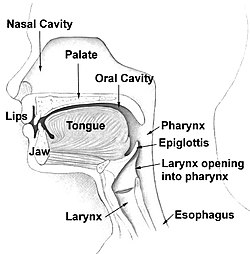
Back Pharynx ALS Farinche AN بلعوم Arabic Farinxe AST МагӀазухъе щекъер цолъулеб бакӀ AV Udlaq Azerbaijani Глотка Byelorussian Глотка BE-X-OLD Гълтач Bulgarian গলবিল Bengali/Bangla
This article needs additional citations for verification. (November 2015) |
| Pharynx | |
|---|---|
 Head and inner neck | |
 Pharynx | |
| Details | |
| Part of | Throat |
| System | Respiratory system, digestive system |
| Artery | Pharyngeal branches of ascending pharyngeal artery, ascending palatine, descending palatine, pharyngeal branches of inferior thyroid |
| Vein | Pharyngeal plexus |
| Nerve | Pharyngeal plexus of vagus nerve, recurrent laryngeal nerve, maxillary nerve, mandibular nerve |
| Identifiers | |
| Latin | pharynx |
| Greek | φάρυγξ (phárynx) |
| MeSH | D010614 |
| TA98 | A05.3.01.001 |
| TA2 | 2855 |
| FMA | 46688 |
| Anatomical terminology | |
The pharynx (pl.: pharynges) is the part of the throat behind the mouth and nasal cavity, and above the esophagus and trachea (the tubes going down to the stomach and the lungs respectively). It is found in vertebrates and invertebrates, though its structure varies across species. The pharynx carries food to the esophagus and air to the larynx. The flap of cartilage called the epiglottis stops food from entering the larynx.
In humans, the pharynx is part of the digestive system and the conducting zone of the respiratory system. (The conducting zone—which also includes the nostrils of the nose, the larynx, trachea, bronchi, and bronchioles—filters, warms and moistens air and conducts it into the lungs).[1] The human pharynx is conventionally divided into three sections: the nasopharynx, oropharynx, and laryngopharynx.
In humans, two sets of pharyngeal muscles form the pharynx and determine the shape of its lumen. They are arranged as an inner layer of longitudinal muscles and an outer circular layer.
- ^ Fasick J (2006). Respiratory Syster (PDF). Benjamin Cummings (Pearson Education, Inc). p. 1. Archived from the original (PDF) on 12 June 2014.